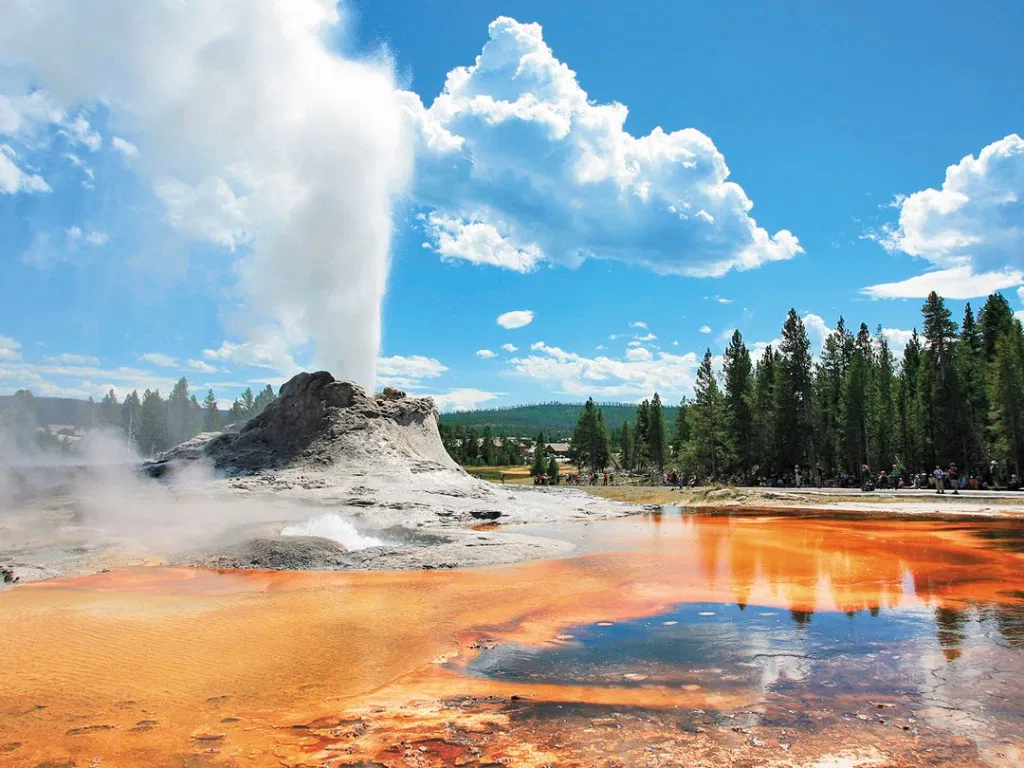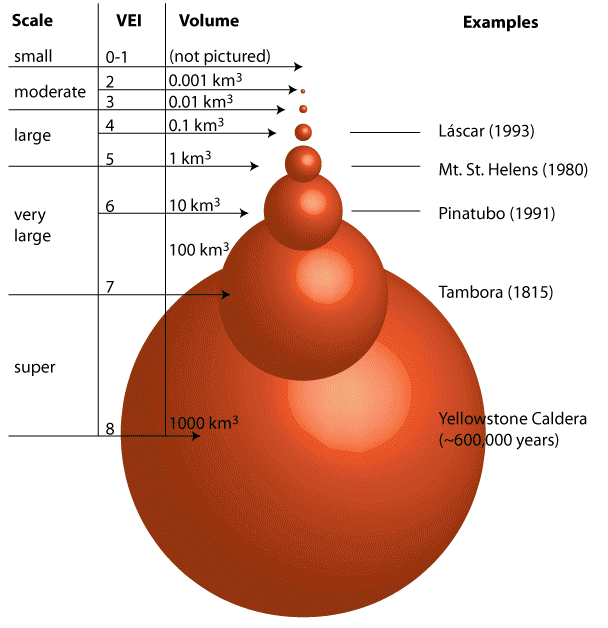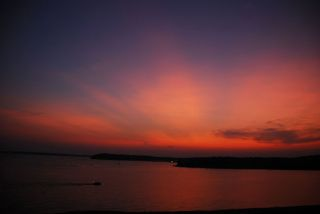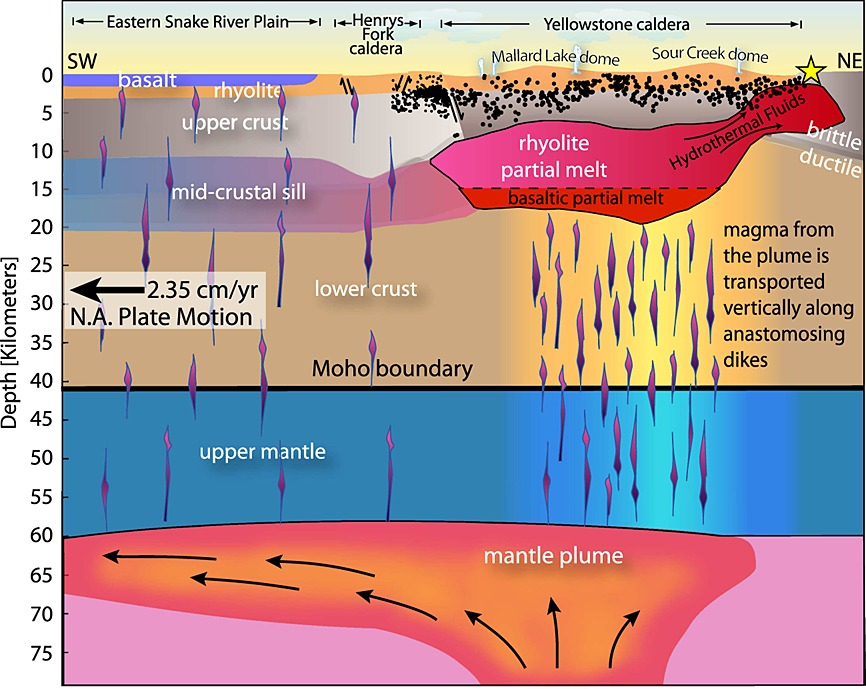#EAPS#EAPS106
- Directly connected to Volcanoes
- The worlds most consequential volcanic eruptions
- Vesuvius (Pompeii)
- St. Helens
- Pinatubo
- Krakatau
- Tambora
- Yellowstone Caldera
- Lake Taupo
- Lake Toba
Mount Vesuvius and Pompeii §
- In 79 AD an eruption of Mt. Vesuvius destroyed the Roman cities of Pompeii and Herculaneum
- 16,000 people were killed (a lot, but not a record)
- An amazing description of the eruption was written down by Pliny the Younger
- Pompeii was preserved by up to 80 feet of ash and dugout, including preserved forms of the dead
- Pompeii and Herculaneum were hit by pyroclastic flows, but Pompeii was also downwind of the eruption and thus buried in 10s of meters of pumice and ash
- Mt Vesuvius is a stratovolcano formed along a subduction zone on the coast of Italy
- Magma is generated beneath Mt. Vesuvius by hydration-induced melting
- Mt. Vesuvius is one of the most active volcanoes in the world, having erupted 50 times in the last 25,000 years
- We have records of one 5000 years ago from footprints of people running away left in the fossilized ash
- Most recently it erupted in 1944
- Over the past 250 years, the ash has been removed to reveal the ancient city of Pompeii, much as it existed 2000 years ago
- On the second day of the eruption, hot toxic clouds of gas and pyroclastic flows overwhelmed Pompeii, killing everyone who had not yet left
- The bodies buried in the ash eventually decayed, leaving hollow spaces
- When found, these spaces were filled with plaster to form casts of the victims at the moments of their deaths
- Plinian eruptions are named after Pliny the Younger, who wrote down an unbelievable account of the eruption of Mt. Vesuvius and the destruction of Pompeii
- His uncle died trying to rescue victims of the eruption
Pompeii in the Movies §
- The Last Days of Pompeii
- Started as a painting based on Pliny the Youngers description - 1800s
- Turned into a historical fiction book telling a love story - 1800s
- Then turned into a silent film, one of the first to be based on a historical event - 1913
- 50 years later it became a movie AGAIN, with a much more elaborate plot and effects etc. - 1959
- The name never changed, they all used the same name
- Another Pompeii movie called…Pompeii - 2014
- Cool special effects, but the movies bad (apparently)
- It shows lava in Mt. Vesuvius, but pressure wouldn’t build if lava was exposed to the surface
- Mt. Vesuvius violently ejected molten rock, pumice, and hot ash, to a height of over 30 kilometers and caused the ground to shake like a large earthquake
- Numerous pyroclastic flows raced down the mountain sides over the course of the two-day eruption
Yellowstone §
- Yellowstone National Park is a jewel amongst a treasure of natural wonderlands in the western United States

- Yellowstone is a hidden super volcano as there are no recognizable volcanoes
- Yellowstone has a hidden caldera underneath and has some volcanic activity going on
- Hot springs are continuously replenished due to straight plumbing
- Geysers erupt periodically due to ends in the plumbing that require a threshold pressure to be achieved before the water/steam can erupt
- Yellowstone geysers and hot springs are fueled by heat from an enormous agma chamber beneath
- Yellowstone is a hot spot volcano, which we know from the trail of extinct volcanoes its at the end of
- In addition to large explosive eruptions, Yellowstone has also had a long history of large lava flows demonstrating the variability of its eruptions
Supereruptions §
- The Volcano Explosivity Index (VEI) rates the relative of explosiveness of volcanoes based on the volume of ash and other rock ejected

- A super eruption at Yellowstone likely had multiple events
- One way that we know Yellowstone has had two super eruptions in its past is from the estimated volume of ash expended by its last three eruptions. The Yellowstone supereruptions covered ~50% of the US in at least several centimeters of ash
- Another indication is the size of the caldera that formed
- A caldera is a large circular depression formed when the surface collapses into an emptying magma chamber
- The 6 mile wide Crater Lake in Oregon is a caldera formed when Mount Mazam erupted 7.700 years ago (VEI 7)
- Greece’s Santorini islands surround the caldera that collapsed after the Minoan eruption (VEI 7) 3500 years ago that wiped out the Minoan civilization
- Yellowstone has three calderas associated with its three explosive eruptions
- Combined with ash fallout and size of pyroclastic flows from each, these were one VEI 7 and two VEI 8 (super) eruptions
- Like all calderas, the Yellowstone caldera is about the size of the magma chamber whose collapse led to its formation
Monitoring a Sleeping Monster §
- Volcanologists monitor earthquake activity, ground deformation, and ground temperature in Yellowstone so as not to be surprised by a sudden eruption
- Yellowstone’s current magma chamber has ben imaged by measuring the change in speed of seismic waves as they pass under the park
- Yellowstone’s seismic network and robust seismicity is used to reveal characteristics of the magma chamber
- Yellowstone’s inferred subsurface structure from seismic imaging
- Uplift of the ground at Yellowstone, as measured by GPS, is related to pressure within the magma chamber
- Satellite thermal infrared temperature measurements can be used to assess whether large temperature increases are occurring over time
- An increase in temperatures over a broad region may indicate a pending eruption
- Aside from significant ash fallout, the other major danger of large volcanic eruptions is global cooling
- Explosive eruptions emit large amounts of Sulfur Dioxide, which mixes with the oxygen and water in the atmosphere to create sulfuric acid droplets
- The ash and sulfuric acid droplets combined block sunlight causing global cooling - the sulfuric acid droplets stay aloft longer than the ash and can thus be more detrimental to climate
- The 1991 eruption of Mt. Pinatubo in the Philippines (VEI 6) generated an ash cloud 1200 kilometers across that than spread out around the globe
- Mt Pinatubo eruption caused a global cooling of about 0.5 degrees Celsius for a year
- The 1815 Tambora eruption (VEI 7) caused about a 1 degree Celsius drop in global temperature
- This triggered a lot of crop failure in the northern hemisphere
- A lot of farmers as a result moved west from New England to find more hospitable climates and better growing conditions. This helped form Indiana in 1816
- Tambora also led to the creation of some popular monsters
- In the cold summer of 1816 Mary Shelley thought up of Frankenstein and John Polidori thought up The Vampyre (precursor to Dracula)
- They were together on a vacation in Switzerland and they held a competition to come up with the best monsters. As a result we got those monsters!
- Arts are often affected by eruptions as well
- The Scream by Edvard Munch was influenced by sunsets in Norway that were altered by the 1887 Krakatoa eruption

- The sunsets are changed due to the eruption affecting the atmosphere, which caused the inspiration for this art

- The global cooling induced by a super eruption would be a great deal bigger
- The Toba supereruption (VEI 8) in Sumatra 74,000 years ago caused 10 years of cooling by 4 degrees Celsius
- This may have triggered the 1000 year long ice age that followed
- Global cooling due to the Toba supereruption has led to two theories regarding human evolution
- First is that it potentially explains a bottleneck detected n human DNA that indicates our population may have been reduced to under 10,000 mating pairs and maybe as few as 1000
- Cooling due to the supereruption might have been concentrated on the Northern Hemisphere, which caused Neanderthals in Europe to decline and led to the rise of humans from Africa
- Giant flood basalts are incredibly large volcanic flows that occur over geologically short time periods (10s of thousands of years)
- Giant flood basalts result from mantle plume heads reaching the surface then melt due to depressurized melting
- The last one to occur is the Columbian River Basalts 17 million years ago
- The Deccan Traps (Swedish word for stairs) was a giant flood basalt covering 1.5 million square kilometers and with 2 kilometer thick flows that occurred over only a 30,000 year period. Short in terms of geology
- Giant flood basalts often correspond with extinction events, which are used to define geologic ages
- The rise and fall of the dinosaurs may have been enabled by giant flood basalts
- The dinosaurs evolved after their reptilian ancestors survived the Permian-Triassic mass extinctions 252 million years ago
- 65 million years ago when an asteroid impact triggered the Deccan Traps, the dinosaurs were then wiped out




